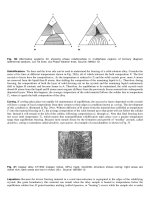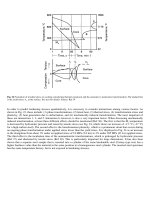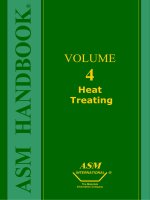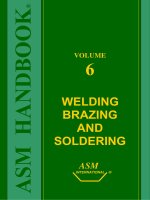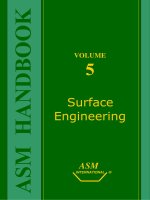Tài liệu ASM Metals HandBook P22 pptx
Bạn đang xem bản rút gọn của tài liệu. Xem và tải ngay bản đầy đủ của tài liệu tại đây (175.3 KB, 10 trang )
Fig. 6 Straight-sided lined cupola introduced after the middle of the 19th century.
The first commercial cupola in the United States was the Colliau cupola, which was introduced in 1874. This cupola was
prefabricated insofar as possible and was built primarily as a commercial product. It was highly successful, being a fast
and economical melting unit. When first introduced, it presented a number of improvements, such as a hot blast, and
double rows of tuyeres. After the Colliau cupola, the Whiting cupola was developed. It is still sold by the company
bearing the name of its inventor, John H. Whiting. In the 1880s, Whiting developed a cupola that employed two rows of
tuyeres, with the lower row arranged to form an annular air inlet that distributed the blast around the entire circumference
of the furnace. The tuyeres could also be adjusted vertically for changes in classes of work, type of fuel, and cupola
diameter. This cupola permitted the use of either coal or coke as a fuel and was equipped with a safety alarm and blast
meter. The Whiting cupola, with its standardized construction, soon proved a boon to foundrymen and was widely
accepted.
Connellsville Coke
The story of the cupola and cast iron in this period would not be complete without reference to the development of
Connellsville coke. Coke was in general use in Europe in 1750, but because of the heavy timber resources of the United
States, it was not produced here until 1817. From that time until 1860, American foundrymen generally made coke for
their own use; after 1860, coke became a commercial product. Connellsville coke was first produced in 1841 at
Connellsville, Pennsylvania, in beehive ovens. The product proved so popular that the demand for Connellsville coke
remained high until 1914, when by product coke came into greater demand.
The use of coke and bituminous coal was made possible by the introduction of the hot-blast furnace in 1828 by James B.
Neilson of Scotland. At first, the blast pipes ran through the furnace. The pipes were later run through a charcoal oven,
and finally they were placed on top of the furnace itself. This device increased melting output from 10 to 40% so that by
1869 the production of coke and bituminous pig iron exceeded that of charcoal pig iron, and by 1875 the use of coke pig
iron alone surpassed that of anthracite pig iron.
Chilled Iron
Another American development of the mid-19th century involved the introduction of chilled-iron railroad car wheels. Asa
Whitney of Philadelphia obtained a basic patent in 1847 on a process for annealing chilled-iron car wheels cast with
chilled tread and flange. They were satisfactory as long as cold-blast charcoal iron was used. However, trouble developed
when melting practice changed from the use of anthracite coal to the hot blast.
In 1880, an attempt was made to introduce manganese for the production of chilled iron, but the resulting product did not
possess adequate wear properties. Finally, a small amount of ferromanganese was introduced directly into the ladle with
good results. Thus originated one of the basic products of the foundry industry--chilled car wheel iron. The excellent
performance of this foundry product, as well as its wear resistance and economical properties, made possible the long-
haul, heavier railroad freight loads of today.
Malleable Iron
No discussion of iron would be complete without mention of American blackheart malleable iron, as contrasted with
European whiteheart malleable iron. Although credit for the progress and growth of the American malleable iron industry
belongs to many, its origin lies with Seth Boyden of Newark, New Jersey.
Boyden's experiments, beginning in 1820, were primarily based on an attempt to duplicate the whiteheart European
product developed by French scientist R.A.F. Réaumur. Boyden was endeavoring to lower the cost of harness hardware
and wanted a strong iron that could be easily machined. Because of a larger percentage of silicon than was available in the
Réaumur process, Boyden was able to produce the strength, but not the white color, of the European product. However,
Boyden (either by design or accident) had shortened the annealing time to 6 or 10 days. This left free temper carbon
graphitization as opposed to Réaumur's decarburization. Boyden first used a crucible and then an air furnace with a
capacity of about 450 kg (1000 lb). His annealing furnace was a beehive unit into which pots loaded with castings were
lowered through the top. The beehive was eventually replace with a continuous annealing furnace having a sloping floor.
This unit was known as a shoving furnace because the pots and castings were shoved in from one end and out the other.
Boyden's work was important, but the most significant advances in the malleable iron field were made by the men who
developed the malleable industry to its level of prominence in the foundry picture. More information on the manufacture
and properties of malleable iron is available in the article "Malleable Iron" in this Volume.
Cast Steel
Next in the chronological sequence of casting developments is steel. For centuries, the goal of manufacturing steel
castings in large quantities was pursued, but inadequate equipment was the limiting factor. In addition, steel was well
known centuries earlier as the Damascus and Toledo sword blades of legendary fame, but this steel was forged from the
pasty masses of iron produced in the Catalan forge. The first reliable record of steelmaking was the work of Huntsman in
England in 1750. Huntsman's developments in crucible refractories (the crucible process) first produced steel that could
be poured as a liquid.
Steel castings are also said to have been discovered by Jacob Mayer, Technical Director of the Bochumer Verein,
Bochum, Germany, sometime before 1851. Records of the Bochumer Verein Company, which is still engaged in
producing steel castings, indicate that cast steel church bells were produced in 1851. Some of these bells weighed as much
as 15 Mg (17 tons). Cast steel guns were also made at the Krupp Works in Germany in 1847. In all probability, much
smaller steel castings were made before the bells were cast, because it is difficult to believe that such large castings would
be attempted without considerable previous experience. The steel church bell castings were displayed at various
expositions throughout Europe and created quite a sensation because of their fine, clear tones and the fact that their selling
price was about half that of the bronze bells formerly in general use. In a park outside of Bochum, one of the early steel
church bells is enshrined as a marker of steel casting history. This bell even escaped the desperate need for scrap steel in
Germany during World War II.
Steel produced by the crucible process remained expensive, and it was not until the converter, the open hearth furnace,
and finally the electric arc furnace were introduced that steel was produced commercially in quantities that were
economically feasible. The steel for these early castings, in addition to being made in crucible furnaces, was poured in
loam molds. It was not until 1845 that steel castings (steel cast to final shape) appeared on the scene. On July 14 of that
year, Swiss metallurgist Johann Conrad Fischer exhibited various small castings produced from crucible steel. On July 23,
1845, Fischer applied to the British Patent Office for priority rights to a new method of making horseshoes that consisted
of casting steel in sand molds.
In the United States, cast steel was produced by the crucible process in 1818 at the Valley Forge Foundry, but difficulties
resulting from the lack of adequate materials--principally refractories for crucibles--caused the experiment to be
abandoned. In 1831-1832, high-quality clay from Cumberland, West Virginia, enabled William Garrard of Cincinnati,
Ohio, to establish the first commercial crucible steel operation in this country. It is interesting to note that the first
commercial steel castings from the Garrard plant sold for 18 to 25 cents per pound and were first used as blades and
guards for the McCormick reaper.
The history of steel castings in the United States begins with the Buffalo Steel Company of Buffalo, New York (later
known as the Pratt and Letchworth Company). The foundry was built in 1860, and in 1861 it produced the first crucible
steel made in the district. Records indicate that these first crucible steel castings were for railroad applications. Some of
the first commercial steel castings produced in the United States are believed to have been made by the William Butcher
Steel Works (later the Midvale Company) near Philadelphia in July of 1867. These castings are said to have been crucible
steel crossing frogs car wheels, probably for the Philadelphia and Reading Railway.
In 1870, William Hainsworth of Pittsburg began the manufacture of cast steel cutting parts for agricultural implements
using a two-pot coke-fired crucible furnace. In 1871, Hainsworth founded the Pittsburg Steel Casting Company, which is
reputed to have been the first company in the country devoted exclusively to the manufacture of steel castings. Some of
the early steel foundries established in this country before 1890 are listed in Table 1.
Table 1 Partial listing of early steel foundries in the United States
Original Location Date of incorporation Now known as
Buffalo Steel Co. Buffalo, NY 1861 Discontinued operations
Wm. Butcher Steel Works Nicetown, PA July 1866 Discontinued operations
Pittsburgh Steel Casting Co. Pittsburgh, PA March 1871 Discontinued operations
Chester Steel Casting Co. Chester, PA 1872 Discontinued operations
Otis Iron and Steel Co. Cleveland, OH Circa 1874 Discontinued operations
Isaac G. Johnson and Co. Spuyten Duyvil, NY Circa 1850
(a)
Discontinued operations
Eureka Steel Castings Co. Chester, PA 1877 Discontinued operations
Hainsworth Steel Co. Pittsburgh, PA Circa 1880 Discontinued operations
Old Fort Pitt Foundry Pittsburgh, PA Circa 1881 MacIntish-Hemphill Div., E.W. Bliss Co.
Solid Steel Casting Co. Alliance, OH August 1882 American Steel Foundries Alliance Works
Standard Steel Castings Co. Thurlow, PA Circa 1882 Discontinued operations
Johnson Steel Street Ry. Co. Johnstown, PA March 1883 Johnstown Corp.
Pacific Rolling Mills Co. San Francisco, CA 1884 Discontinued operations
S.G. Flagg and Co. Philadelphia, PA 1882-1885 Discontinued operations
Cowing Steel Castings Co. Cleveland, OH 1882-1885 Discontinued operations
Sharon Steel Casting Co. Sharon, PA February 1887 Discontinued operations
(a)
Began making steel castings in 1880
William Kelly, whose invention of the converter clearly anticipated the work of Sir Henry Bessemer (although the latter
gave his name to the unit), first operated his converter in 1851, a full 5 years before Bessemer's patent was obtained.
Neither man realized that his efforts were being paralleled by the other, but it has been well established that Kelly was the
first to use the converter.
Kelly developed his idea out of experiments on the refining of pig iron as a result of his inability to obtain high-quality
ore at his works in Eddyville, Kentucky. His theory was that the iron in ore is not metallic but a chemical compound of
oxygen and iron. He came to the conclusion that, after the metal was melted, additional fuel would not be required but
that the heat generated by the union of the oxygen in air with the carbon in the metal would be sufficient to decarburize
the iron. Kelly's associates, fearing for his sanity, sent him to a doctor for treatment, with the result that the doctor agreed
to back Kelly in his venture. In 1851, he was able to produce a rather soft steel, but had difficulty with high carbon. In the
meantime, in England, Sir Henry Bessemer was working along almost identical lines. However, he had metallurgical
assistance. Robert Mushet of England developed an alloy of iron, carbon, and manganese that purified the metal and
ensured the presence of enough carbon to make steel. Although Bessemer obtained American patents, Kelly proved his
patent priority in 1857, and in 1866 Kelly and Bessemer joined forces.
A Kelly converter was first used in 1857-1858 at the Cambria Works at Johnstown, Pennsylvania. Later, Kelly obtained
the rights to use Mushet's patent. Bessemer's first converter in the United States was installed at Troy, New York, in 1865.
This converter was introduced into foundries and was further improved in 1891 by the Tropenas converter (Fig. 7), which
blew over the surface of the metal rather than through it. The lower-pressure blast and resultant deeper metal bath
produced better results.
Fig. 7 The Bessemer and Tropenas converters.
The converter had scarcely gained acceptance when another furnace came into use and gave the steel industry the
capacity it required. This was the Siemens-Martin open hearth, a development dating back to 1845, plus the succeeding
experiments of J.M. Heath. However, this unit did not become successful until the great heat of the open hearth


